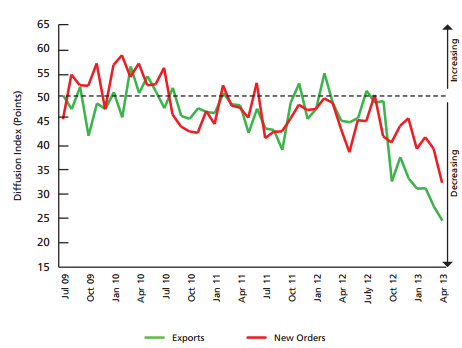A major casualty of China's slowdown has been one of its key natural resources supplier, Australia. Many Australians feel misled by all the projections of China's growing demand, believing that China will continue beating its yearly 8% growth projections.
The Australian: China outperformed for a decade its own government's 8 per cent growth target, which was lowered to 7.5 per cent for last year and this year.
Australia's budget planners were confident China's economy would keep surpassing the official target.
They forecast that China's economic growth, the core driver for Australian commodity sales and thus of our formerly burgeoning terms of trade, would bottom out at 8.5 per cent last year, rebounding higher this year. The current budget also was based on 2012 growth reaching 6.25 per cent in India, and 2.25 per cent in Japan.
But China's growth for last year ended up at 7.8 per cent, India's at 4.5 per cent and Japan's at 2 per cent. The forecasts were thus overestimated by 8.3 per cent, 28.1 per cent and 8.9 per cent respectively.
China is Australia's top export buyer, Japan the second and India the fourth. So these outcomes had a big impact on budgeted receipts.
Last year's budget papers forecast "economic conditions in China to remain solid", and that Australian resource companies, high-end manufacturers, service providers and rural commodity producers would all gain more opportunities "as the Asian Century proceeds", brandishing the government's mantra of the day. They insisted that "China has the capacity to use macro-economic policy to stimulate growth", and that terms of trade would remain "close to their highest sustained levels in 140 years".
Australian Industry Group: - Reflecting ongoing weakness in the global economy and the high Australian dollar, the manufacturing exports sub-index worsened again in April. The exports sub-index fell 2.9 points to 24.5 (seasonally adjusted) in April, marking the ninth consecutive month of contraction and the lowest reading for the exports sub-index in the history of this series (commencing in 2004) .
Australia's overall manufacturing index hit the lowest level since 2009, with the nation's manufacturing sector in full contraction.
The Reserve Bank of Australia has been holding rates steady for much too long, believing in some sort of miracle from China (per government's forecast). What makes their job particularly difficult is the fact that both the U.S. and Japan are conducting unprecedented monetary expansion, thus putting upward pressure on the Australian dollar. And that makes Australian products less competitive in global markets, particularly versus South American competitors.
The Australian: [Matthew Johnson (UBS)] said any further easing in the US would force the RBA to cut interest rates to stop the [Australian] dollar from being propelled higher.
Now the RBA has little choice but to ease monetary policy by lowering short term rates. Given the worsening economic fundamentals and most major central banks' highly accommodative policies, the RBA will be forced to abandon its normally hawkish stance. It may be Australia's turn to enter the currency war. 
- English (UK)
- English (India)
- English (Canada)
- English (Australia)
- English (South Africa)
- English (Philippines)
- English (Nigeria)
- Deutsch
- Español (España)
- Español (México)
- Français
- Italiano
- Nederlands
- Português (Portugal)
- Polski
- Português (Brasil)
- Русский
- Türkçe
- العربية
- Ελληνικά
- Svenska
- Suomi
- עברית
- 日本語
- 한국어
- 简体中文
- 繁體中文
- Bahasa Indonesia
- Bahasa Melayu
- ไทย
- Tiếng Việt
- हिंदी
Australia's Turn To Enter The Currency War?
Published 05/02/2013, 12:53 AM
Updated 07/09/2023, 06:31 AM
Australia's Turn To Enter The Currency War?
3rd party Ad. Not an offer or recommendation by Investing.com. See disclosure here or
remove ads
.
Latest comments
Install Our App
Risk Disclosure: Trading in financial instruments and/or cryptocurrencies involves high risks including the risk of losing some, or all, of your investment amount, and may not be suitable for all investors. Prices of cryptocurrencies are extremely volatile and may be affected by external factors such as financial, regulatory or political events. Trading on margin increases the financial risks.
Before deciding to trade in financial instrument or cryptocurrencies you should be fully informed of the risks and costs associated with trading the financial markets, carefully consider your investment objectives, level of experience, and risk appetite, and seek professional advice where needed.
Fusion Media would like to remind you that the data contained in this website is not necessarily real-time nor accurate. The data and prices on the website are not necessarily provided by any market or exchange, but may be provided by market makers, and so prices may not be accurate and may differ from the actual price at any given market, meaning prices are indicative and not appropriate for trading purposes. Fusion Media and any provider of the data contained in this website will not accept liability for any loss or damage as a result of your trading, or your reliance on the information contained within this website.
It is prohibited to use, store, reproduce, display, modify, transmit or distribute the data contained in this website without the explicit prior written permission of Fusion Media and/or the data provider. All intellectual property rights are reserved by the providers and/or the exchange providing the data contained in this website.
Fusion Media may be compensated by the advertisers that appear on the website, based on your interaction with the advertisements or advertisers.
Before deciding to trade in financial instrument or cryptocurrencies you should be fully informed of the risks and costs associated with trading the financial markets, carefully consider your investment objectives, level of experience, and risk appetite, and seek professional advice where needed.
Fusion Media would like to remind you that the data contained in this website is not necessarily real-time nor accurate. The data and prices on the website are not necessarily provided by any market or exchange, but may be provided by market makers, and so prices may not be accurate and may differ from the actual price at any given market, meaning prices are indicative and not appropriate for trading purposes. Fusion Media and any provider of the data contained in this website will not accept liability for any loss or damage as a result of your trading, or your reliance on the information contained within this website.
It is prohibited to use, store, reproduce, display, modify, transmit or distribute the data contained in this website without the explicit prior written permission of Fusion Media and/or the data provider. All intellectual property rights are reserved by the providers and/or the exchange providing the data contained in this website.
Fusion Media may be compensated by the advertisers that appear on the website, based on your interaction with the advertisements or advertisers.
© 2007-2024 - Fusion Media Limited. All Rights Reserved.
